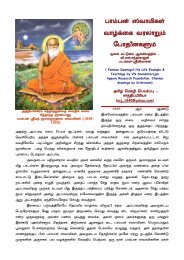MALAYSIAN HINDU PILGRIMAGE: KAVADI ... - Murugan Bhakti
MALAYSIAN HINDU PILGRIMAGE: KAVADI ... - Murugan Bhakti
MALAYSIAN HINDU PILGRIMAGE: KAVADI ... - Murugan Bhakti
Create successful ePaper yourself
Turn your PDF publications into a flip-book with our unique Google optimized e-Paper software.
ender him both acceptable and accessible to all layers of Tamil society (Clothey:p.71). Within theanti-Brahman milieu that constitutes a leitmotif of modern Tamil politics in Malaysia (Amplavanar),<strong>Murugan</strong> can be portrayed as a Dravidian god par excellence, freed from the imagined despotism ofnorthern “Aryan” traditions.Given this context, it is not surprising that Thaipusam, a major festival dedicated to <strong>Murugan</strong>, hasemerged as the largest and most widely observed Malaysian Hindu festival. Its growing popularity asexpressed in the ever increasing crowds (over one million devotees journeyed to Batu Caves for the2001 festival) and the swelling ranks of kavadi (ritualized burden) bearers, underscores its perceivedrelevance to Malaysian Hindus.While Thaipusam in Malaysia is consciously modelled upon the mythology, traditions and ritualscelebrated at Palani, Tamil Nadu, the processes of relocation and adaptation have endowed it with acharacter which is uniquely Malaysian.MYTHOLOGY:MURUGAN’S ROLEAmong Malaysian Hindus, Thaipusam is usually is described as a festival commemorating <strong>Murugan</strong>’sacquisition of the Sakti Vel (electric spear or Vetrivel) bestowed upon him by Parvati, consort of Siva,at the commencement of <strong>Murugan</strong>’s campaign to defeat Surapadman, head of the Asura-s (demons orlower astral beings).The mythology which describes the creation of <strong>Murugan</strong> and the cosmic role accorded to him beginswith Siva’s withdrawal from the world to concentrate upon austerities and meditation. However, priorto his retreat, he granted extensive boons to the asura-s, Surapadman, and his two brothers, all ofwhom had been performing powerful tapa-s (austerities) to him. In Siva’s absence, the asura-s, headedby Surapadman, quickly conquered the world. They created terror among the celestials, and subjectedthem to countless indignities. Their rule was characterized by torture, persecution, and a total disregardfor the laws of dharma.The celestials petitioned Siva to intervene on their behalf. In response to their entreaties Siva sproutedfive additional heads and from each of his (now) six heads produced a divine spark. The sparksultimately matured into the forms of six baby boys, who were each assigned to the individual care ofone of the six Pleiades maidens (Krttika-s). Later, upon seeing their rightful mother, Parvati, the sixbabies rushed to her and were embraced, so that they fused into one being with six heads and twelvearms, the form of <strong>Murugan</strong> known as Shanmugam or Aramugam.Throughout his brief infancy, Shanmugam displayed extraordinary talents, sometimes engaging inchildish behaviour which reflected lack of awareness of his own strength and intrinsic qualities.Characteristic actions included upending mountains, damming the waters of the Ganges, and alteringthe orbits of the planets (Handelman:p.140). His most celebrated childhood act was the imprisonmentof Brahma. Brahma had refused to acknowledge <strong>Murugan</strong>’s divine status as the son of Siva. <strong>Murugan</strong>,annoyed, had asked Brahma a series of questions regarding the inner meaning of the profound mysticalsymbol, the Pravana Aum. When Brahma could not answer, <strong>Murugan</strong> had him beaten and thrown intojail. Siva, alerted to this development, approached Shanmugam and playfully requested him to explainthe significance of this sacred symbol. Dutifully <strong>Murugan</strong> instructed his father in the mysteries of thePravana Aum.Following his boyhood, <strong>Murugan</strong> was presented with the Vel by Parvati. Accompanied by his generalsand an army of Deva-s (celestials), <strong>Murugan</strong> left Mt. Kailas, Siva’s abode in the north of India, andheaded southwards to combat the asura-s.The great battle raged for six days. The final phase of the conflict resulted in the direct confrontation of<strong>Murugan</strong> and Surapadman, the demon king. Realizing the immense power of <strong>Murugan</strong>, and that defeatin a straight fight was inevitable, Surapadman employed all the illusory powers he had been taught,assuming the forms of a number of birds and animals. However, <strong>Murugan</strong> was beyond any delusion,and quickly flushed Surapadman from each of his disguises. Toward the conclusion of the battle,<strong>Murugan</strong> appeared before Surapadman in “…his own true and eternal form: the cosmos and all of its


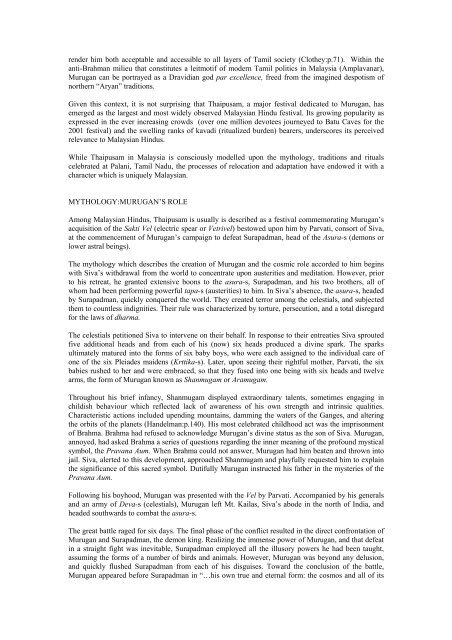
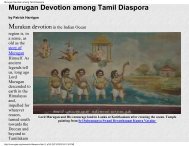
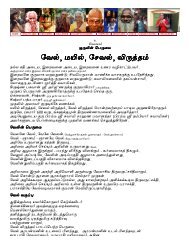
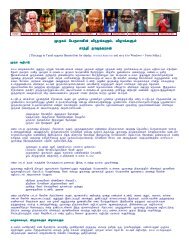
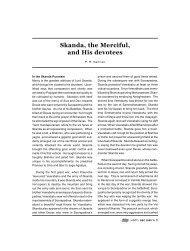
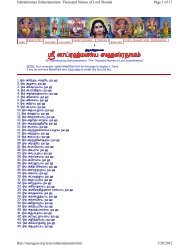
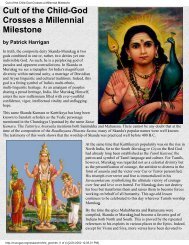
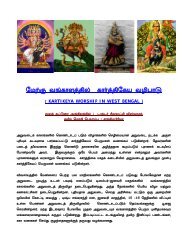
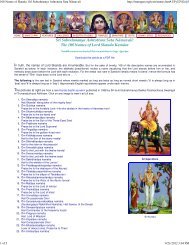
![gHdp k]y Myaj;jpw;F ghj ahj;jpiu fpuhkpa gHf;f Kiwfs;](https://img.yumpu.com/10245948/1/184x260/ghdp-ky-myajjpwf-ghj-ahjjpiu-fpuhkpa-ghff-kiwfs.jpg?quality=85)

